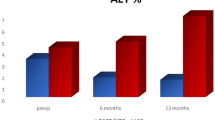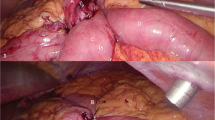Abstract
Introduction
Patients with one-anastomosis gastric bypass (OAGB) can develop gastroesophageal reflux disease (GERD). The nature of this GERD (acid or biliary) remains unclear.
Objective
To assess the nature of GERD via impedance pH testing in patients presenting with reflux post OAGB.
Methods
Retrospective analysis of a prospectively collected database of 43 patients with OAGB backgrounds who developed postoperative GERD and were investigated with impedance pH monitoring between 2006 and 2019.
Results
Mean age was 52.48 ± 9 years. Mean body mass index (BMI) prior to OAGB was 46.82 kg/m2. None of these patients had clinical GERD before surgery. The median time interval between surgery and investigation with 24-h impedance pH monitoring was 64 (56) months. The mean BMI at the time of investigations was 32.67 ± 6.9 kg/m2. The type of reflux was acid in 13 (30.2%), non-acid (biliary) in 12 (27.9%), and mixed (acid and biliary) in 5 (11.6%) patients. However, it remained not confirmed in 13 (30.2%). Median DeMeester score was 48.95 (27.67) in patients with acid, 2.8 (7.4) in patients with biliary, and 28.7 (5.6) in patients with mixed reflux. Median percent of time spent with pH < 4 was 9.65 (8) in patients with acid, 0.6 (1.75) in patients with biliary, and 7.7 (3.9) in patients with mixed reflux.
Conclusion
Acid reflux seems to be as common as bile reflux in patients presenting with GERD after OAGB. In case of revisional surgery for severe GERD post OAGB, 24-h impedance pH monitoring could be essential to determine the surgical procedure of choice.


Similar content being viewed by others
References
Rutledge R. The mini-gastric bypass: experience with the first 1274 cases. Obes Surg United States. 2001;11:276–80.
Mahawar KK, Himpens J, Shikora SA, et al. The first consensus statement on one anastomosis/mini gastric bypass (OAGB/MGB) using a modified Delphi approach. Obes Surg United States. 2018;28:303–12.
Chakhtoura G, Zinzindohoué F, Ghanem Y, et al. Primary results of laparoscopic mini-gastric bypass in a French obesity-surgery specialized university hospital. Obes Surg United States. 2008;18:1130–3.
Chevallier JM, Arman GA, Guenzi M, et al. One thousand single anastomosis (omega loop) gastric bypasses to treat morbid obesity in a 7-year period: outcomes show few complications and good efficacy. Obes Surg. 2015;25:951–8.
Jammu GS, Sharma R. A 7-Year Clinical Audit of 1107 Cases comparing sleeve gastrectomy, Roux-En-Y gastric bypass, and mini-gastric bypass, to determine an effective and safe bariatric and metabolic procedure. Obes Surg United States. 2016;26:926–32.
Musella M, Susa A, Greco F, et al. The laparoscopic mini-gastric bypass: the Italian experience: outcomes from 974 consecutive cases in a multicenter review. Surg Endosc. 2014;28:156–63.
Noun R, Skaff J, Riachi E, et al. One thousand consecutive mini-gastric bypass: short- and long-term outcome. Obes Surg United States. 2012;22:697–703.
Angrisani L, Santonicola A, Iovino P, et al. IFSO worldwide survey 2016: primary, endoluminal, and revisional procedures. Obes Surg United States. 2018;28:3783–94.
Angrisani L, Santonicola A, Iovino P, et al. Bariatric surgery survey 2018: similarities and disparities among the 5 IFSO chapters. Obes Surg. 2021:1–12.
Mahawar KK, Carr WRJ, Balupuri S, et al. Controversy surrounding “mini” gastric bypass. Obes Surg United States. 2014;24:324–33.
Johnson WH, Fernanadez AZ, Farrell TM, et al. Surgical revision of loop (“mini”) gastric bypass procedure: multicenter review of complications and conversions to Roux-en-Y gastric bypass. Surg Obes Relat Dis Off J Am Soc Bariatr Surg United States. 2007;3:37–41.
Poghosyan T, Caille C, Moszkowicz D, et al. Roux-en-Y gastric bypass for the treatment of severe complications after omega-loop gastric bypass. Surg Obes Relat Dis Off J Am Soc Bariatr Surg. 2017;13:988–94.
Bruzzi M, Duboc H, Gronnier C, et al. Long-term evaluation of biliary reflux after experimental one-anastomosis gastric bypass in rats. Obes Surg United States. 2017;27:1119–22.
M’Harzi L, Chevallier J-M, Certain A, et al. Long-term evaluation of biliary reflux on esogastric mucosae after one-anastomosis gastric bypass and esojejunostomy in rats. Obes Surg United States. 2020;30:2598–605.
McQuaid KR, Laine L, Fennerty MB, et al. Systematic review: the role of bile acids in the pathogenesis of gastro-oesophageal reflux disease and related neoplasia. Aliment Pharmacol Ther England. 2011;34:146–65.
Doulami G, Triantafyllou S, Albanopoulos K, et al. Acid and nonacid gastroesophageal reflux after single anastomosis gastric bypass. An objective assessment using 24-hour multichannel intraluminal impedance-pH metry. Surg Obes Relat Dis Off J Am Soc Bariatr Surg United States. 2018;14:484–8.
Saarinen T, Pietiläinen KH, Loimaala A, et al. Bile reflux is a common finding in the gastric pouch after one anastomosis gastric bypass. Obes Surg. 2020;30:875–81.
Keleidari B, Mahmoudieh M, Davarpanah Jazi AH, et al. Comparison of the bile reflux frequency in one anastomosis gastric bypass and Roux-en-Y gastric bypass: a cohort study. Obes Surg United States. 2019;29:1721–5.
Kassir R, Petrucciani N, Debs T, et al. Conversion of one anastomosis gastric bypass (OAGB) to Roux-en-Y gastric bypass (RYGB) for biliary reflux resistant to medical treatment: lessons learned from a retrospective series of 2780 consecutive patients undergoing OAGB. Obes Surg United States. 2020;30:2093–8.
Mahawar KK. Attention to technical details is important for best outcomes with one anastomosis gastric bypass. Obes Surg. 2018;28:2920–1.
Mahawar KK, Parmar C, Graham Y. One anastomosis gastric bypass: key technical features, and prevention and management of procedure-specific complications. Minerva Chir Italy. 2019;74:126–36.
Carbajo MA, Luque-de-León E, Jiménez JM, et al. Laparoscopic one-anastomosis gastric bypass: technique, results, and long-term follow-up in 1200 patients. Obes Surg. 2017;27:1153–67.
Slagter N, Hopman J, Altenburg AG, et al. Applying an anti-reflux suture in the one anastomosis gastric bypass to prevent biliary reflux: a long-term observational study. Obes Surg United States. 2021;
Olmi S, Oldani A, Cesana G, et al. Laparoscopic one anastomosis gastric bypass versus laparoscopic one anastomosis gastric bypass with Braun anastomosis: what’s better? J Laparoendosc Adv Surg Tech A United States. 2019;29:1469–74.
Tolone S, Cristiano S, Savarino E, et al. Effects of omega-loop bypass on esophagogastric junction function. Surg Obes Relat Dis Off J Am Soc Bariatr Surg United States. 2016;12:62–9.
Carbajo M, García-Caballero M, Toledano M, et al. One-anastomosis gastric bypass by laparoscopy: results of the first 209 patients. Obes Surg United States. 2005;15:398–404.
Gordon C, Kang JY, Neild PJ, et al. The role of the hiatus hernia in gastro-oesophageal reflux disease. Aliment Pharmacol Ther England. 2004;20:719–32.
Burgerhart JS, van de Meeberg PC, Siersema PD, et al. Nocturnal and daytime esophageal acid exposure in normal-weight, overweight, and obese patients with reflux symptoms. Eur J Gastroenterol Hepatol England. 2014;26:6–10.
Parmar CD, Mahawar KK. One anastomosis (mini) gastric bypass is now an established bariatric procedure: a systematic review of 12,807 patients. Obes Surg. 2018;28:2956–67.
Magouliotis DE, Tasiopoulou VS, Tzovaras G. One anastomosis gastric bypass versus Roux-en-Y gastric bypass for morbid obesity: an updated meta-analysis. Obes Surg United States. 2019;29:2721–30.
Ramos AC, Chevallier J-M, Mahawar K, et al. IFSO (International Federation for Surgery of Obesity and Metabolic Disorders) consensus conference statement on one-anastomosis gastric bypass (OAGB-MGB): results of a modified Delphi study. Obes Surg United States. 2020;30:1625–34.
Triadafilopoulos G. Acid and bile reflux in Barrett’s esophagus: a tale of two evils. Gastroenterology United States. 2001;121:1502–6.
Author information
Authors and Affiliations
Corresponding author
Ethics declarations
Ethics Approval
For this type of study formal consent is not required.
Consent to Participate
Informed consent does not apply.
Conflict of Interest
The authors declare no competing interests.
Additional information
Publisher’s Note
Springer Nature remains neutral with regard to jurisdictional claims in published maps and institutional affiliations.
Key Points
1. Acid reflux seems to be common in patients presenting with GERD after OAGB.
2. Impedance pH monitoring is important to determine the type of revisional procedure.
3. In case of postoperative acid reflux, revision to regular Roux-en-Y gastric bypass (RYGB) seems suitable.
4. In case of postoperative biliary reflux, revision to diverted OAGB could be performed.
Rights and permissions
About this article
Cite this article
Nehmeh, W.A., Baratte, C., Rives-Lange, C. et al. Acid Reflux Is Common in Patients With Gastroesophageal Reflux Disease After One-Anastomosis Gastric Bypass. OBES SURG 31, 4717–4723 (2021). https://doi.org/10.1007/s11695-021-05542-3
Received:
Revised:
Accepted:
Published:
Issue Date:
DOI: https://doi.org/10.1007/s11695-021-05542-3




